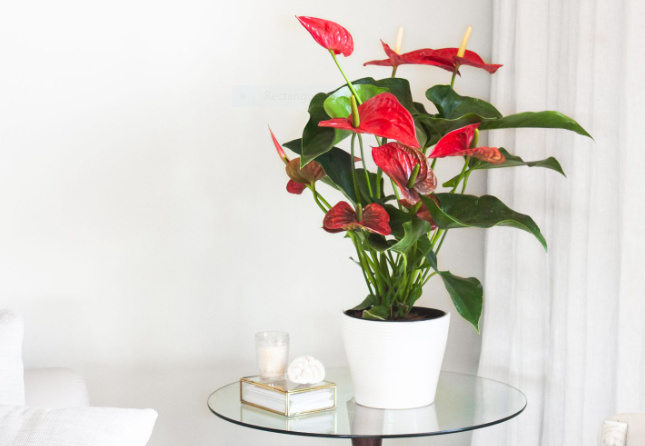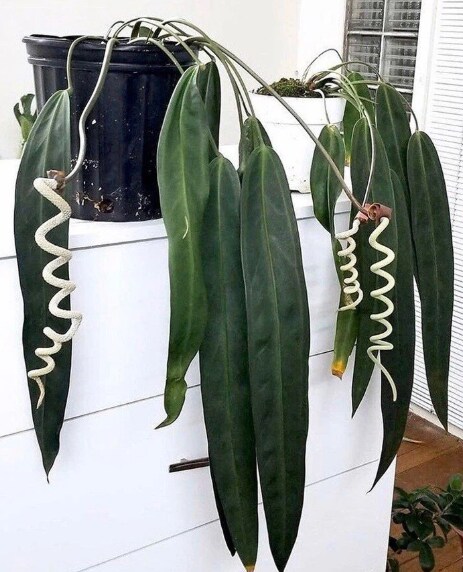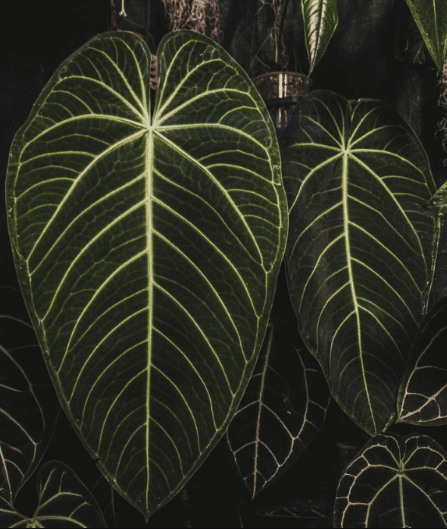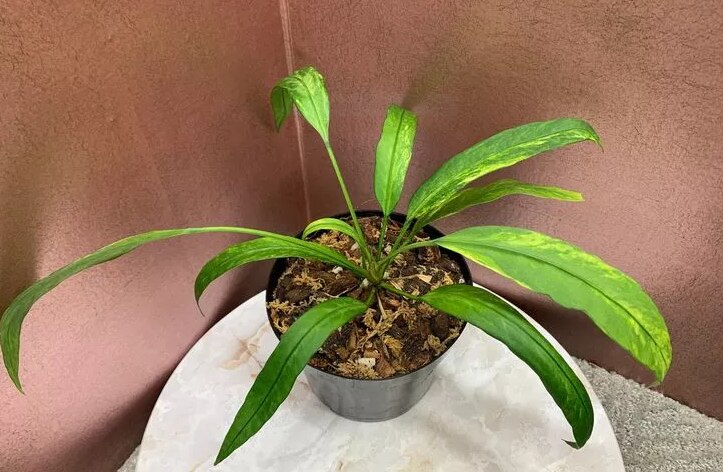Anthurium Magnificum: Origin, Appearance, Hybrids, and Care
Anthurium Magnificum, also referred to as Laceleaf, is a stunning tropical plant with large, heart-shaped leaves and bright red flowers. Its leaves are velvety to the touch, have a deep green color, and reach an impressive size at maturity. The plant is terrestrial and thrives in a well-draining, organic medium that mimics its natural habitat.
In this care and growing guide, we will briefly discuss this variety, its habitat, morphological character, care requirements, and propagation methods to grow it perfectly!
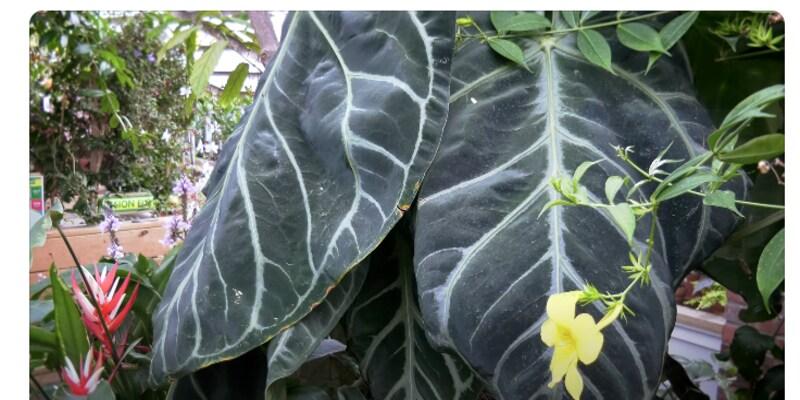
What is Anthurium Magnificum? Origin & Appearance (Leaves, Petioles, and Inflorescence)
Anthurium magnificum is a famous tropical plant known for its stunning foliage. Its dark green leaves are shaped like elephant ears. The texture of leaves is leathery and velvety with complex veins. It is a terrestrial plant that grows at intermediate elevation on the western slopes of the Andes Mountains at an altitude of 800-2125 meters.

1. Anthurium Magnificum Origin:
Anthurium Magnificum originally comes from the Colombian regions of Risaralda and Crundinamarca, which naturally grows on trees and rocky surfaces. This tropical plant also produces unique flowers like other members of the Aracea family.
2. Anthurium Magnificum Leaves:
Anthurium Magnificum produces dark green leaves that are velvety to the touch. All the leaves have prominent basal lobes with white or silvery veins and can grow to a very large size. They are cordate or heart-shaped in appearance and are very tiny when immature. The emerging young leaves are deep burgundy that change to orange and light green before maturing to deep dark green.
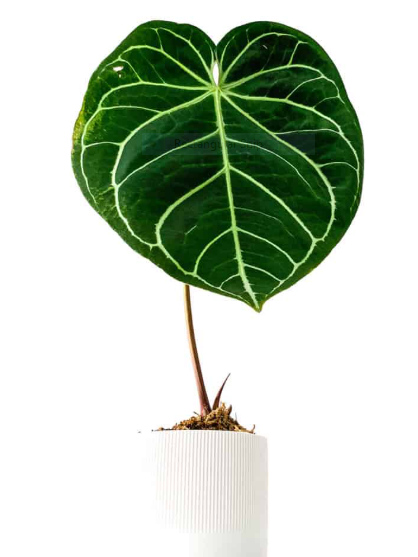
3. Anthurium Magnificum Petioles:
The Laceleaf Anthurium produces squarish or tetrahedral and narrow-winged petioles.
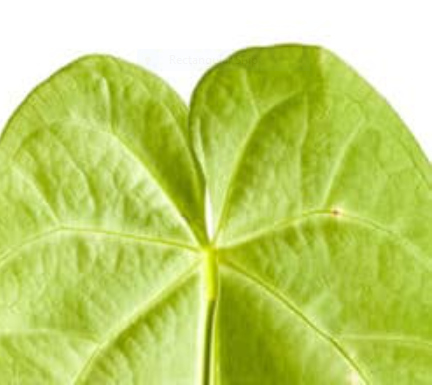
4. Anthurium Magnificum Inflorescence:
The flower, or rather an inflorescence, is key to pollinating and propagating Anthuriums. Anthurium Magnificum also has perfect flowers or inflorescence. It means that they can produce both male and female flowers on the same inflorescence. A new inflorescence comes out of an existing leaf petiole and may take many weeks or months from pollination to the successful harvest of the berries.
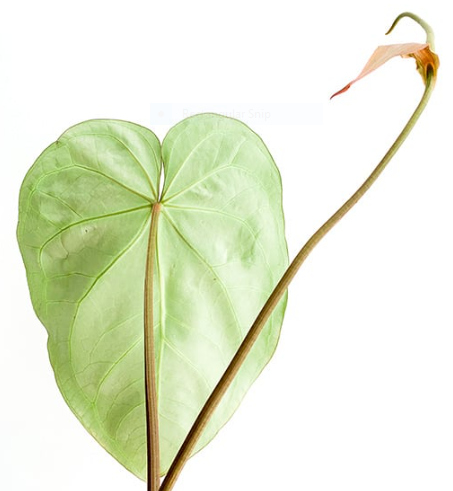
Anthurium magnificum: Verde vs Norte
1. Anthurium Magnificum Verde:
There is no definitive knowledge available on the internet about Anthurium magnificum Verde and Anthurium magnificum Norte. Some people believe that the Anthurium magnificum Verde is a different species, while others say it is the same species with different appearances due to various geographical conditions.
Verde has dark green leaves that are different in appearance from Anthurium magnificum. Its elongated leaves have silvery veins that are less noticeable.
2. Anthurium Magnificum Norte:
According to the given information, Magnificum norte is an ecotype. Its petiole has five sides, unlike regular anthurium, which has only four.
Top 7 Anthurium Magnificum Hybrids
Anthurium Magnificum is often hybridized with other anthuriums to produce offsprings that exhibit the characteristics of both parents. However, their identifications become difficult.
With that in mind, let’s look at the top 7 coolest Anthurium magnificum hybrids.
1. Anthurium Magnificum x Papillilaminum
Anthurium magnificum x papillilaminum hybrid has the distinct lobes of an Anthurium papillilaminum and the roundness of magnificum. It will be a stunning addition to your Araceae plant family collection.
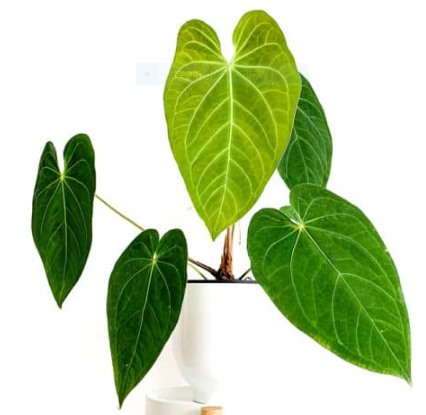
2. Anthurium Magnificum x Moronense
Anthurium magnificum x moronense hybrid’s unusual leaf shape takes after Anthurium moronense, which sports three-lobed leaves. Its leaves will look quite different when the plant matures, as they have the velvety texture of magnificum.
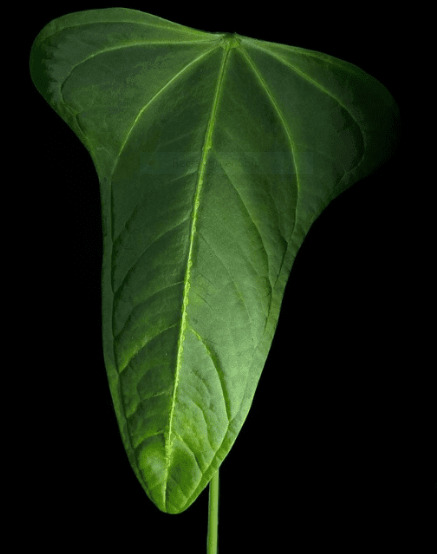
3. Anthurium Magnificum x Luxurians
Anthurium magnificum x luxurians is one of the most stunning hybrids that combines the heart-shaped leaves of magnificum combined with the pebbled-like texture of Anthurium luxurians.
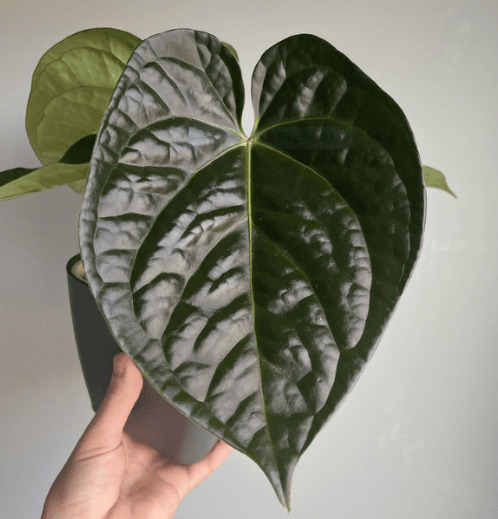
4. Anthurium Magnificum x Dressleri
The magnificum x dressleri is a magnificent hybrid that produces dark and velvety leaves. It combines squarish petioles from telltale of magnificum, and the reddish shimmery tint on the pillowy leaves is a dressleri trait.
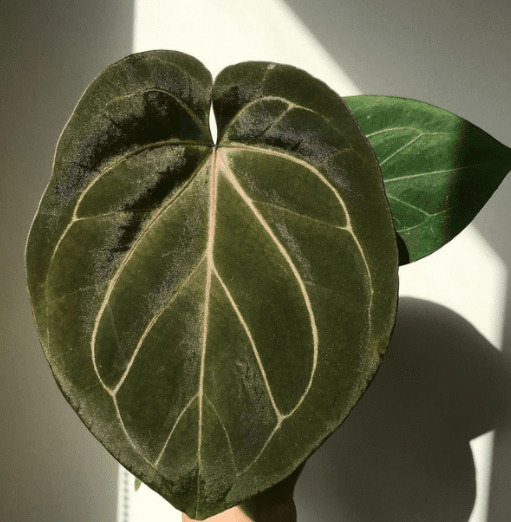
5. Anthurium Magnificum x Regale
The magnificum x regale hybrid is called Anthurium Petir in Indonesia, which means lighting because it produces vibrant foliage.
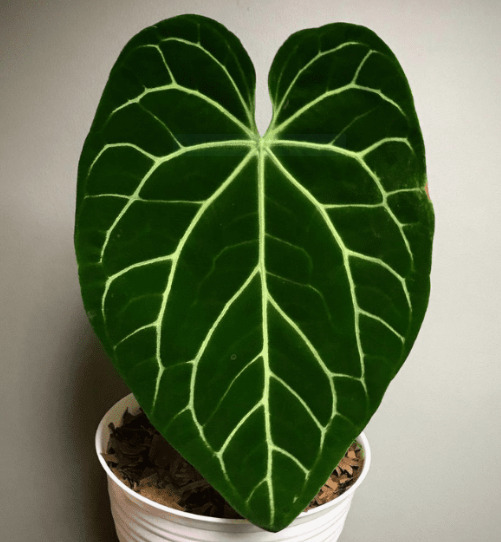
6. Anthurium Magnificum x Forgetii
Anthurium Magnificum x Forgetii is a smaller hybrid with dark green foliage.
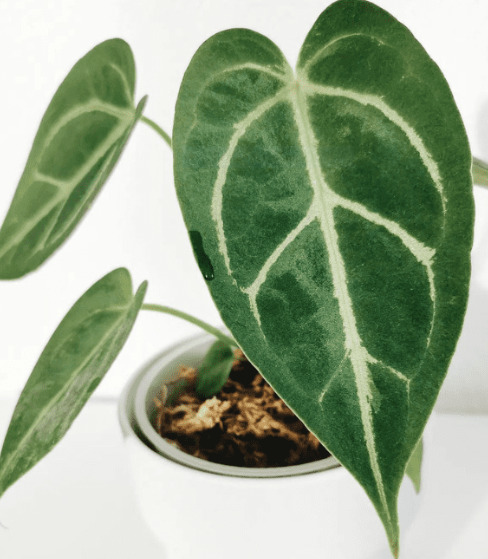
8. Anthurium Magnificum x Crystallinum
Anthurium magnificum x crystallinum is often called Anthurium magnificum silver. The plant has square and winged petioles after Magnificum, and the elongated leaves with strong silver veining indicate the presence of Anthurium Crystallinum.
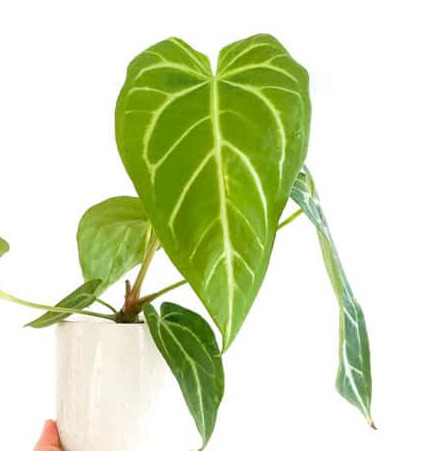
How to Grow and Care for Your Anthurium Magnificum?
Follow the tips and requirements below to grow and care for your Anthurium Magnificum Indoors:
1. What are the light requirements for Anthurium Magnificum?
Anthurium magnificum requires a large amount of sunlight to thrive.
Following these tips ensures your plant receives bright and indirect light during the day. Longer internodes, smaller leaves, elongated petioles, and reduced growth indicate that your anthurium magnificum is not receiving enough sunlight.
Burning of leaves indicates that your plant is getting too much sunlight, which is harmful to your anthurium magnificum. To protect from direct sun rays, you can use curtains or shades.
2. Which type of soil is best for your Anthurium Magnificum?
Anthurium magnificum loves to grow in well-drained or moist soil. Fungal growth, waterlogged roots, wilting, and yellowing of leaves indicate that your plant is facing the problem of poor soil. This can also attract pests to attack your plant.
If you want the best potting mixture for your plant,
3. Anthurium Magnificum Repotting Requirements
The process of repotting depends on the growth of anthurium magnificum. If growth is faster, you can repot your plant every 2-3 years. The growing season (summer and spring) is the best time for repotting.
During repotting, loose packing of soil around the roots is always preferred. Tightly packing can cause root rot because it restricts oxygen flow.
4. What are the water requirements for Anthurium magnificum?
Like many other tropical plants, Anthurium Magnificum thrives in moist soil with proper watering. If green leaves start wilting and turning yellow, it indicates that your plant is facing the problem of excess watering. If your plant is growing in soggy soil, it can cause root rot and mushy stems. For protection, wait until the soil becomes dry.
When you water your longleaf plant:
5. How much temperature is needed for Anthurium Magnificum?
This tropical plant loves to bloom in warm temperatures. For healthy growth, the best temperature range for Anthurium Magnificum is 65-80 degrees Fahrenheit.
This plant requires less water during its dormant season(winter).
6. How much humidity does Anthurium Magnificum require to thrive?
This longleaf houseplant loves humidity—the more humidity, the better the growth. Give your plant at least 60 percent humidity to make it happy and healthy. High humidity helps your plant grow well and protects it from diseases or pests like spider mites and mealybugs.
When healthy green leaves turn dry with edges, it indicates a high humidity level. On the other hand, mold or root rot indicates low humidity.
Practical ways to safely increase the humidity level for your plant:
You can increase the humidity level in the following ways:
7. When to fertilize your Anthurium Magnificum?
Anthurium magnificum grows best with balanced fertilizers during summer and spring. Improper feeding of fertilizer can cause root rot or burn your plant’s leaves.
I have always preferred diluting liquid fertilizer because it works well. You should apply fertilizer once a month. Avoid over-fertilizing, which can turn dark green leaves yellow or dark brown.
To solve this problem, you should reduce fertilizing your plant and flush all the soil with clean water. Flushing will easily remove excess salt.

Anthurium Magnificum Common problems
Like other tropical plants, anthurium magnificum also faces some common problems. Let’s dive into how to identify these problems and resolve them quickly.
1. Leaf spot
Due to different reasons, various spots are formed on the leaves of Anthurium magnificum.
If you spot any unusual marks, try to diagnose the cause. If you suspect a bacterial issue, apply neem oil, which can protect your plant. If it is a fungal infection, use fungicides. Follow the instructions on the label.
2. Yellow leaves
The yellowing of leaves indicates that your plant is facing several issues, such as:
Overwatering can cause waterlogging, so first, allow the soil to dry. If there is any nutrient deficiency, I prefer balanced fertilizer, which helps to boost plant growth.
3. Spider mites
Spider mites are too small and sometimes invisible to see with the naked eye. To see them directly, use web-like structures.
Use neem oil to treat the affected stems and leaves of your plant. Do this weekly until your anthurium magnificum looks healthy and pretty again.
Increase the humidity around your plants to keep them healthy in the future. To boost plant growth, you can use a pebble tray or a humidifier.
Also Check What is ANTHURIUM CLARINERVIUM?
FAQS
1. Is Anthurium Magnificum rare?
Yes, anthurium magnificum is a rare one. This houseplant is not commonly available at local markets or grocery stores. But don’t worry; you can get this from online plant stores and special nurseries to add this tropical beauty to your indoor garden.
2. How do you propagate your Anthurium Magnificum?
You can propagate anthurium magnificum through division and stem-cutting methods.
3. Is Anthurium Magnificum toxic?
Yes, anthurium magnificum is a toxic tropical plant containing calcium oxalate crystals. Please keep it away from humans and pets.
Conclusion
That’s all for the Anthurium Magnificum. The plant is native to Colombia and produces stunning dark green leaves with flowers when properly cared for. Ideally, you can grow this tropical plant by meeting its needs, such as indirect light, balanced fertilizers, and proper watering. A suitable environment can keep your plant happy and healthy. With this essential guide, you can enjoy the vibe of this stunning tropical foliage.

